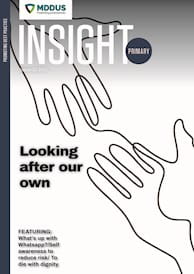 SAFETY netting is an important aspect of patient care. It plays a key role in reducing the likelihood of a delayed or missed diagnosis, particularly where there is diagnostic uncertainty, and ensures patients at risk of significant deterioration are reviewed appropriately.
SAFETY netting is an important aspect of patient care. It plays a key role in reducing the likelihood of a delayed or missed diagnosis, particularly where there is diagnostic uncertainty, and ensures patients at risk of significant deterioration are reviewed appropriately.
Be specific
Within a consultation there are a number of elements which contribute to effective safety netting. These include ensuring a patient is given advice on the likely timescale for resolution or improvement of their current symptoms and the specific clinical features to look out for that would suggest a deterioration or alternative diagnosis.
Patents should also be provided with information on when and how to re-consult. It is important for clinicians to be as specific as possible: information that is too general or vague may result in patients missing the relevance or importance of the advice. Written information such as leaflets or text messages can provide additional support in reinforcing advice but should not be seen as a substitute for verbal communication.
Uncertainty
It is not uncommon for patients to consult when they first experience symptoms and at this early stage it may be difficult to make a definitive diagnosis. Patients should be made aware of any uncertainty in a diagnosis, which can be helpful in empowering them to take appropriate action if they have concerns subsequently.
Check understanding
It is important once advice is given to check that the patient has understood it and is clear on what to look out for and when to seek further help. If further investigations are required, the patient should be made aware of their purpose and urgency, how results will be communicated and what follow-up may be necessary. Similarly, if a referral is being made, the patient should be informed of when they might expect to hear about an appointment and what action to take if they do not hear within the timeframe given.
Clear record
Safety netting advice should be clearly and specifically documented. Failure to do so makes it more difficult to evidence what was discussed and can impact continuity of care. Statements such as "safety-netting advice given" offers little insight to colleagues in subsequent consultations and will be of limited assistance, for example, if a patient complains or pursues a claim and suggests they were not informed about red-flag symptoms.
Follow-up
Another key aspect of safety netting which contributes to reducing risk is ensuring that systems are in place within your organisation to support follow-up.
There should be clear processes in place which all clinicians and support staff are aware of. Examples include:
- a pathway for the management and communication of abnormal results
- a process to check any referrals initiated are followed through
- systems to alert the organisation when a patient does not attend a planned follow-up.
Non-clinical staff should be aware of what to do when a patient, acting on safety-netting instructions, contacts the practice or department.
Safety netting can be particularly important in certain patient groups, such as young children, vulnerable adults or patients who have multiple co-morbidities. For example, a child’s condition can change very quickly and clear information should be provided on the symptoms to look out for and what to do in the event the child’s condition deteriorates. Consider whether in some circumstances it would be more appropriate to proactively book the patient in for follow-up.
Remote consulting
Safety netting is vital in remote consultations, where any physical assessment is likely to be limited. In addition, effective communication can be difficult and poor audio or video connections will exacerbate this. It is particularly important in these circumstances to check patients have heard and understood the advice provided.
ACTION POINTS
- Ensure any safety-netting advice you provide is specific and that the patient is aware of any diagnostic uncertainty.
- Document all the advice you have provided.
- Consider whether providing written information might be useful to reinforce verbal advice.
- Ensure your organisation has robust procedures in place to support patient follow-up.
- Recognise scenarios where communication may need to be adapted and additional safety-netting advice or follow-up arranged, such as consultations with children or vulnerable patients.
This page was correct at the time of publication. Any guidance is intended as general guidance for members only. If you are a member and need specific advice relating to your own circumstances, please contact one of our advisers.
Read more from this issue of Insight Primary

Save this article
Save this article to a list of favourite articles which members can access in their account.
Save to library


